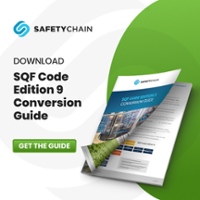SQF Code Edition 9: What Changed & How to Implement
If your facility isn’t yet fully prepared for SQF Edition 9, you’re not alone. According to a SafetyChain poll, just 3% of respondents were completely ready for the changes as of January 2021.
With the SQF Edition 9 implementation date in the past, now is the time to familiarize yourself with what’s changed since SQF Edition 8.1 and to perform a gap assessment to prepare your facility ASAP. Here, we cover everything you need to know about the latest SQF food safety code to get your plant ready.
What Is SQF Code Edition 9
The SQF Code Edition 9 is the most recent version of the Safe Quality Food (SQF) Code, a GFSI-recognized Certification Program that helps food and beverage companies, as well as packaging, storage and distribution and primary production facilities, meet stringent food safety and quality requirements. The implementation deadline for SQF Code Edition 9 was May 24, 2021.
Layout & Design: SQF 8.1 vs. SQF Edition 9
In SQF 8.1, the Primary Production Code was one Code with one set of system elements applicable to the various primary modules: plant, livestock, and aquaculture. With Edition 9, the various primary modules are separated into three distinct codes, SQF Food Safety Code: Primary Animal Production, SQF Food Safety Code: Primary Plant Production, and SQF Food safety Code: Aquaculture. There are also different system elements for the three industry segments, with the relevant risks identified for each.
In the SQF Code Edition 9, primary plant production also now encompasses pack houses, which were previously grouped under manufacturing.
There are also now five different codes for manufacturing. Under Edition 8.1, all manufacturing elements were found under one code. In Edition 9, the manufacturing modules are separated into the following codes:
SQF Food Safety code: Animal Product Manufacturing
SQF Food Safety code: Food Manufacturing
SQF Food Safety code: Dietary Supplements
SQF Food Safety code: Pet Food Manufacturing
SQF Food Safety code: Animal Feed Manufacturing
SQFI will create individual guidance documents and tools tailored for each Code.
The SQF Quality Code still has its own category, but one major change is that it can now be used with any GFSI-recognized standard. Previously, it could only be used with SQF.
Edition 9 also comes with enhancements to the organization and structure of the Codes. For example, there is now increased white space, color coding, and a new font to enhance readability.
SQF Edition 9: Part A Technical Changes
Part A of the SQF Code features several changes, the most noteworthy of which are listed here.
Scoring Changes
Scores for non-conformities are important changes to Edition 9. While major non-conformities were scored at 10 points in 8.1 and earlier versions, they’ve now been decreased to 5 points. SQFI approached this change from a site perspective: since auditors are often inclined to score similar issues as many separate minor non-conformities instead of a single major one, this scoring adjustment may encourage auditors to group issues together. In turn, it will prompt sites to investigate the root causes of system element breakdowns.
Unannounced Audits
GFSI has updated the requirements for unannounced audits. Previously, one unannounced audit was required for every certification cycle. Now, your facility must undergo an unannounced audit within three years of the previous one. This change is reflected in the SQF Code Edition 9.
Desk Audits
The requirement for desk audits for initial certifications has been removed in Edition 9. Auditors will now proceed directly to site audits instead of performing desk audits first.
Audit Duration Table
The audit duration guide provided by GFSI has been removed in Edition 9. Nonetheless, it can still be referenced in previous editions.
Remote Audit Activities
A portion of SQF audits can now be performed remotely, including interviews, as well as certain record checks and document reviews. Remote audits start with a feasibility study. This will assess the capabilities of both the site and the auditor.
If/Then Table for Failures
To help managers within food companies better understand the corrective measures and potential consequences associated with failures, an “if/then” table is available for easy reference.
Technical Changes of SQF Edition 9: Part B
While there are many technical changes within Part B of the SQF Code, the following updates have the greatest potential to impact your facility and therefore deserve the most immediate attention.
Addition of Food Safety Culture (2.1.1.2)
SQF Code Edition 9 incorporates food safety culture as its own requirement, which reflects the new GFSI requirement of the same nature. While food safety culture has always been a fundamental component of the SQF Program, it is now auditable. Thus, how a site demonstrates a culture of food safety, including its training, documentation, and other resources made available to employees, will be evaluated by auditors.
Contact Manufacturers: High vs. Low Risk (2.3.3.2)
Edition 9 also introduces clarified requirements for low-risk contract manufacturers. Low-risk manufacturers must still demonstrate compliance, but there is new verbiage to indicate the differences between these sites and those with an elevated risk.
Requirements for Changeovers & Label Reconciliation (2.6.1.2)
Mislabeling of allergens is one of the most common reasons for recalls. Oftentimes, allergen labeling mishaps occur during changeovers. Edition 9 identifies procedures surrounding changeovers in packaging to promote label reconciliation is maintained, which aims to ensure the right products are placed in the right packages with the correct labels.
Internal Testing (2.4.4.2)
To ensure food safety is controlled, sites that perform internal testing must identify which tests pertain to food safety under Edition 9. For instance, if your company uses internal labs for pH or pathogenic testing, you must outline which tests and methodologies are used. Internal labs do not have to be accredited to ISO 17025.
Training Requirements (2.9.2.1)
Edition 9 lists additional training requirements for testing and sampling. New requirements pertain to allergen and environmental management training.
Adequate Ventilation (11.1.6.1)
SQF Code Edition 8.1 only addressed ventilation with environments that had kettles. Now, a separate requirement has been added to indicate which environments must meet ventilation requirements such as positive air systems.
Ambient Air Testing (11.7.1.2)
This topic received considerable attention when Edition 9 was available for public comments. Many individuals advised making ambient air testing a requirement only for high-risk processes. Edition 9 reflects this recommendation and will require a risk assessment for potential threats, along with testing as appropriate.
PCs in Storage, Distribution, & Feed Standards (2.4.3)
GFSI recently updated its language to require storage, distribution, and feed standards to have a hazard and risk management system. This latest change opens the door to include the reference to CCPs or PCs. The SQF Code Edition 9 reflects this change, so standards are not exclusive to the CODEX HACCP.
Additional Requirements for Water Testing (7.6.2.1)
In the Primary Production Code, additional requirements for testing irrigation water have been added based on identified risks.
SQF Code Edition 9 FAQs & Top 9 Changes
(Click the image to download.) Even though the Edition 9 implementation deadline is behind us, many members of the Food & Beverage industry still have questions about the requirements in Edition 9. Here are a few of the most common questions SQFI has encountered.
When will the SQF Edition 9 checklist and documents be posted?
Edition 9 checklists are available on the SQFI website. For instance, an Excel spreadsheet with numbering changes from Version 8.1 to 9 is now live. Guidance documents are currently underway.
How will certification bodies (CBs) determine the audit duration without the table?
CBs can still refer to the table for audit duration, even though it was left out of the Codes. This change was done intentionally so that duration will no longer be auditable to allow for greater flexibility.
How will previous unannounced audits fit into the change in the unannounced audit requirement?
The schedule will now be based on a site’s most recent unannounced audit. Your site must have one within three years of its previous audit. This is a slight variation from SQF Code Edition 8.1., which called for an unannounced audit every certification cycle.
Will the implementation date be postponed due to COVID-19?
SQFI reports that postponement for Edition 9 implementation is unlikely.
How will the new numbering affect my policy and procedures?
Sites are not required to update the numbering of their policies and procedures to align with those in Edition 9. Your facility’s alignment with the requirements of the Edition 9 Code is most important. An auditor should not mark you for numbering that doesn’t align with that of the Code, however, as this is not a requirement.
How will “food safety culture” be interpreted by the auditor?
Tips and guidance for implementing a culture of food safety will be available in the upcoming Edition 9 Guidance Documents. The documents outline expectations for the site and auditor. If you’d like to make sure your site is in compliance now, you can refer to GFSI’s elements of food safety culture, available on the GFSI website.
What tests would fall under the new requirement for internal sampling and testing?
Only the tests that pertain to food safety fall under the requirement.
Will the SQF Program continue to be recognized by GFSI with the implementation of Edition 9?
Yes, the SQF Program will continue to be a GFSI-recognized certification program with the rollout of Edition 9.
SQF Code Edition 9 Implementation: Best Practices
Keep in mind that surveillance audits will be conducted to the Code against which they were certified. For example, if your site received a score for an audit against SQF Code Edition 8.1 that put it under surveillance, the surveillance audit will be against SQF 8.1.
SQF Edition 9 Recommendations
As you move your site from SQF 8.1 to SQF Edition 9, here are some best practices to guide you.
Start by completing a gap analysis within your facility to identify necessary changes.
Next, use the corrective action register and road map to help you identify which changes to implement to ensure compliance.
After changes have been completed, perform a formal internal audit to verify compliance.
Document SQF practitioner meetings with management on a standardized agenda with meeting minutes.
Start cultivating a strong food safety culture by cascading SQF sponsorship from top management throughout the organization with the SQF practitioners as champions of the process.
If needed, use a third party to help with or verify compliance.
Start now: prepare your facility fully well before May 2021!
Be sure to uncover any key gaps which could affect your certification status if left unaddressed. This will give you ample opportunity to update your processes to align with the new code.
See how SafetyChain helps support compliance with GFSI-recognized schemes, including SQF, in this guide.



